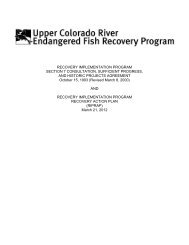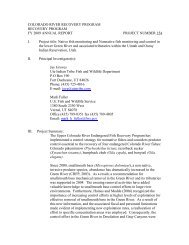K. R. Bestgen, K. A. Zelasko, and G. C. White. Monitoring ...
K. R. Bestgen, K. A. Zelasko, and G. C. White. Monitoring ...
K. R. Bestgen, K. A. Zelasko, and G. C. White. Monitoring ...
You also want an ePaper? Increase the reach of your titles
YUMPU automatically turns print PDFs into web optimized ePapers that Google loves.
Yet another aspect of sampling <strong>and</strong> analysis could be formal occupancy analysis of<br />
sampling data. This involves multiple samples collected from the same location (could be in<br />
concert with releases described above) <strong>and</strong> at several locations. The advantage is occupancy<br />
estimation analysis allows for estimation of probability of occurrence (here, larvae) in the face of<br />
imperfect detection information (i.e., the idea that larvae may not be detected even when present,<br />
with inherent methods to correct for that; see Falke et al. [2010] for more information) <strong>and</strong> is<br />
especially useful if number of larvae increases over time. This would be especially useful for<br />
Larval Trigger study assessments, which will rely on knowledge of occupancy of larvae in<br />
wetl<strong>and</strong>s in late spring-early summer to guide sampling later in summer or autumn.<br />
Taxonomic verification of larvae.—Identification of larvae with traditional<br />
morphological <strong>and</strong> pigment characteristics works well for most specimens captured in light traps<br />
(Snyder <strong>and</strong> Muth 2004). This is true because razorback sucker larvae hatch early <strong>and</strong> at a<br />
smaller size than other native suckers <strong>and</strong> have earlier (at a smaller size) development of key<br />
structures through the early life history stage. Compared to the commonest non-native, the white<br />
sucker Catostomus commersonii, larvae of razorback sucker have key morphological<br />
development event differences (gut coiling), transitions to various larval life stages (e.g., flexion<br />
to post-flexion mesolarvae) occurs at a smaller size, <strong>and</strong> pigmentation patterns are quite different<br />
than the aforementioned species. However, with the increase in abundance of non-native<br />
catostmids (e.g., white sucker) <strong>and</strong> increased hybridization rates among various native <strong>and</strong> nonnative<br />
catostomids in some portions of the basin, verification of specimens determined to be of<br />
questionable taxonomic identity could be very useful. A previous study using allozymes<br />
documented that traditional techniques are very accurate to identify razorback suckers (pers.<br />
comm., D. Probstel, formerly of Colorado State University) since nearly all razorback suckers<br />
<strong>and</strong> those identified as questionable were in fact bona fide razorback suckers. More recently <strong>and</strong><br />
using other techniques, a few fish identified as razorback suckers or razorback suckers where<br />
identity was slightly questionable (“razorback sucker?”) were identified using genetic techniques<br />
as some other taxa (J. Wood, Pisces Molecular, Boulder, Colorado); sample size for study<br />
specimens <strong>and</strong> reference fish species was low, reference fish identity may have been<br />
questionable, <strong>and</strong> the number of molecular markers resolved was small so the results are still<br />
under review. Regardless, reliable genetic techniques based on samples of known razorback<br />
sucker specimens <strong>and</strong> those of other reference species to benchmark results, would verify<br />
efficacy of traditional taxonomy, determine whether traditional techniques are useful to identify<br />
22










